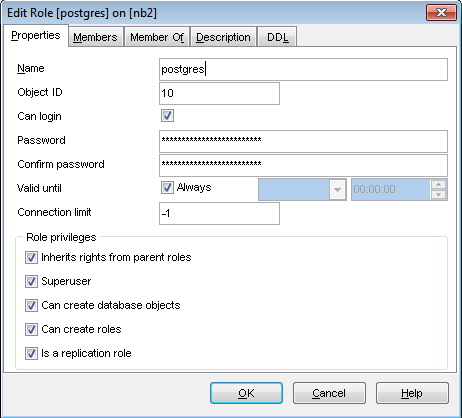Online Documentation for SQL Manager for PostgreSQL
Editing properties
Use the Properties tab of Role Editor to specify properties of the user/group being created/edited.
Name
Specifies the name by which the role is identified in the server.

Object ID
This field displays the OID of the role being created/edited. This value is read-only.
![]() Can login
Can login
This option specifies whether the role can be used to login (user) or not (role).
Password / Confirm password
Enter/confirm a password to identify the role.
Valid until
Check ![]() Always if you do not want to restrict the role validity term, or set the role expiration date/time (i.e. the date and time after which the role's password is no longer valid) using the corresponding controls. It is possible to set the date value manually by typing it in, or using the date editor which is activated when you click the value box.
Always if you do not want to restrict the role validity term, or set the role expiration date/time (i.e. the date and time after which the role's password is no longer valid) using the corresponding controls. It is possible to set the date value manually by typing it in, or using the date editor which is activated when you click the value box.
Connection limit
Specify how many concurrent connections the role can make (the default is -1 indicating that the number of connections is unlimited).
Role privileges
![]() Inherits rights from parent roles
Inherits rights from parent roles
This option determines whether the role inherits the privileges of role(s) it is a member of.
![]() Superuser
Superuser
This option determines whether the role is a superuser, who can override all access restrictions within the database.
![]() Can create database objects
Can create database objects
This option defines the role's ability to create database objects.
![]() Can create roles
Can create roles
This option determines whether the role will be permitted to create new roles (i.e. execute CREATE ROLE).
![]() Is a replication role
Is a replication role
This option determines whether a role is allowed to initiate streaming replication or put the system in and out of backup mode.
![]() Can modify catalog directly
Can modify catalog directly
This option determines whether the role can modify system catalog directly or not.
Note: This option is only available if Superuser is specified for the role.



































































